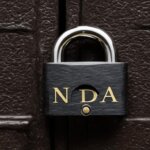Table of Contents
In today’s business world, sensitive information is often a valuable commodity, and companies go to great lengths to safeguard it. One of the essential tools that companies use to protect confidential information is a Non-Disclosure Agreement, commonly referred to as an NDA form.
An NDA form is a legally binding document that outlines the terms of confidentiality between two or more parties. It specifies that certain information shared between the parties is to remain confidential and not to be disclosed to unauthorized individuals. In this section, we’ll cover what an NDA form is, its significance in protecting vital information, and how it works.
Key Takeaways
- An NDA form is a legal document used to establish a confidential relationship between two or more parties.
- The NDA outlines the terms and conditions under which the parties agree to protect and not disclose certain confidential information.
- An NDA form is an essential tool for protecting sensitive information such as trade secrets, business strategies, and customer data.
- Violating the terms of an NDA form can result in legal consequences, including financial penalties and damages.
- By signing an NDA form, parties commit to keeping the information confidential, ensuring that valuable business information remains secure.
What is an NDA Form?
An NDA form, also known as a non-disclosure agreement, is a legal document that establishes a confidential relationship between two or more parties. It outlines the terms and conditions under which the parties agree to protect and not disclose certain confidential information shared between them.
The purpose of an NDA form is to ensure that sensitive information remains confidential and prevents unauthorized disclosure. It is often used to safeguard trade secrets, product designs, customer data, and other confidential information from falling into the wrong hands.
Once an NDA form is signed, the parties involved commit to keeping the information confidential and refrain from sharing it with unauthorized individuals or using it for personal gain. Violating the terms of the NDA form can result in legal consequences, including financial penalties and damages.
The Significance of an NDA Form in Protecting Information
An NDA form plays a crucial role in safeguarding sensitive information. By signing the agreement, parties involved commit to keeping the information confidential and refrain from sharing it with unauthorized individuals or using it for personal gain. This ensures that trade secrets, business strategies, customer data, and other confidential information are protected from being disclosed to competitors, the general public, or anyone not authorized to access the information.
In addition to establishing confidentiality, an NDA form helps to build mutual trust between the involved parties. It shows that the parties take the sharing of information seriously and are committed to maintaining its secrecy. This can be particularly important in business transactions, where the disclosure of confidential information could have significant consequences.
Violating the terms of the NDA form can result in legal consequences, including financial penalties and damages. Therefore, it is essential to ensure that the NDA form is carefully drafted and that all parties involved understand its terms and conditions.
Examples of Information Protected by an NDA Form
| Confidential Information | Examples |
|---|---|
| Trade Secrets | Manufacturing processes, customer lists, product designs, financial data |
| Business Strategies | Marketing plans, pricing strategies, sales tactics |
| Customer Data | Personal information, purchase history, contact details |
As demonstrated by the table above, an NDA form can protect a wide range of information. Regardless of the specific type of information, an NDA form is an essential legal tool for any business or individual looking to safeguard their confidential information.
Conclusion
In conclusion, an NDA form is a vital legal tool for protecting sensitive information shared between parties. It establishes a confidential relationship and sets out the terms of confidentiality, ensuring that the information remains confidential and not disclosed to unauthorised individuals. By understanding and using NDA forms correctly, parties can establish trust, protect their intellectual property, and maintain the confidentiality of valuable business information.
It is essential to ensure that the NDA form is written clearly and precisely to avoid any potential misunderstandings or legal disputes down the line. Parties should also ensure that the terms of the agreement are fair and reasonable to all parties involved.
To further protect sensitive information, parties can also take additional measures, such as implementing robust data encryption measures and establishing clear data security procedures. By taking these steps, parties can safeguard their confidential information and prevent unauthorised access or data breaches.
Ultimately, an NDA form is a vital tool for any business or individual looking to protect sensitive information. By understanding its significance and using it appropriately, parties can protect their valuable intellectual property and maintain trust with their clients and partners.
FAQ
What is the purpose of an NDA form?
The purpose of an NDA form, also known as a non-disclosure agreement, is to establish a confidential relationship between parties and ensure the protection of sensitive information. It outlines the terms and conditions under which the parties agree to keep certain information confidential and not disclose it to unauthorized individuals.
Who should use an NDA form?
Any individual, company, or organization that wants to safeguard their confidential information should use an NDA form. It is commonly used in business transactions, partnerships, employment agreements, and collaborations where sensitive information needs to be protected.
What information is typically covered in an NDA form?
An NDA form typically covers a wide range of confidential information, including trade secrets, financial data, customer lists, proprietary technology, business strategies, marketing plans, and any other information identified as confidential by the parties involved.
What happens if someone breaches an NDA form?
If someone breaches an NDA form by disclosing confidential information without authorization, they could face legal consequences. These consequences may include financial penalties, damages, and even legal action. It is important to take breaches of NDA forms seriously to protect the integrity of confidential information.
How long is an NDA form valid?
The duration of an NDA form can vary and is typically determined by the parties involved. It can be valid for a specific period of time, such as one year or three years, or it can remain in effect indefinitely, depending on the nature of the confidential information and the agreement reached between the parties.
Can an NDA form be modified or terminated?
Yes, an NDA form can be modified or terminated by mutual agreement between the parties involved. If there is a need to make changes to the terms or terminate the agreement, it is recommended to document these modifications in writing and ensure that all parties involved are aware of and agree to the changes.












